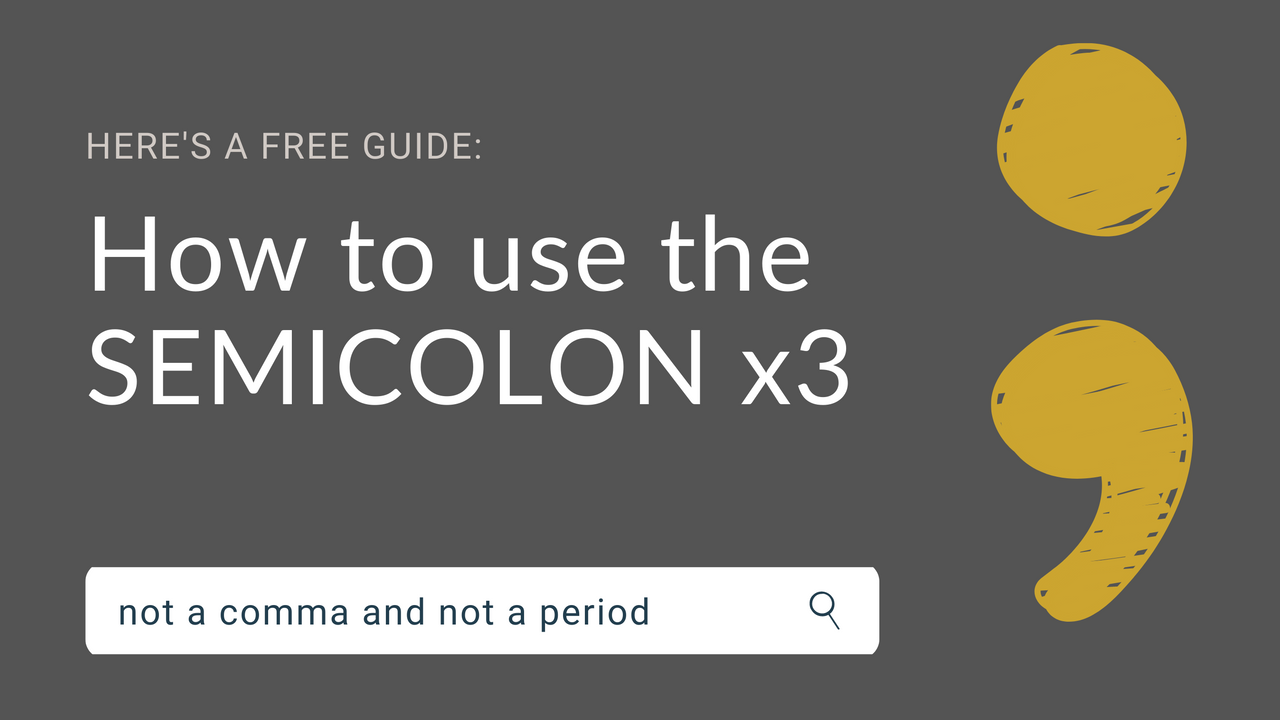
Not a comma and not a period: The Semicolon
Nov 01, 2021Today I posted a quick guide about semicolons on IG. Why? Because I recently read the most confusing 'simple' article about the semicolon and decided to do better.
So, off we go:
The time has come, and you are thinking about writing something in English. As usual, you use punctuation. BUT it's kinda super important to use commas, periods, colons, and semicolons somewhat correctly. 🤷♀️ Or not; who cares?
Let me start with a recap of the short + convenient 3 step guide I posted on IG today to help you put back semicolons into their rightful place. Period.
First, the bad news
Semicolons are not interchangeable with commas or periods. They're somewhere in between: more potent than a comma but not quite as divisive as a period.
1. Semicolons connect related independent clauses
Simply put, the group of words that comes before the semicolon should form a complete sentence; the group of words that comes after the semicolon should form a complete sentence. The two sentences should share a close, logical connection.
e.g. I ordered pizza for lunch; life is too short for counting calories.
2. Use it instead of a conjunction like and, but, or
A semicolon isn't the only thing that can link two independent clauses. Ands, buts, and ors can do that too. But you shouldn't use a semicolon plus a conjunction.
e.g. I spoke to Olivia; she seems to be happy.
3. Semicolons in a serial list
If items on a list are long or have internal punctuation, you can use semicolons to divide the items. This makes reading less confusing.
e.g. I need the weather statistics for the following cities: London, England; London, Ontario; Paris, France; Paris, Ontario; Perth, Scotland; Perth, Ontario.
What else is to be said?
Famous writer Kurt Vonnegut threw shade on the semicolon. "First rule: Do not use semicolons. They are transvestite hermaphrodites representing absolutely nothing. All they do is show you've been to college."
Later he went on writing: "And there, I've just used a semicolon, which at the outset I told you never to use. It is to make a point that I did it. The point is: Rules only take us so far, even good rules."
A little bit of history
The first printed semicolon was the work of the Italian printer Aldus Manutius, the Elder, in 1496. Manutius established the practice of using the semicolon to separate words of opposed meaning and to allow a rapid change in direction in connecting interdependent statements. Ben Jonson was the first notable English writer to use the semicolon systematically. The current uses of the semicolon relate either to the listing of items or to the linking of related clauses (see points 1 and 3 in my list above).
Another place in time
In rare cases, when a comma replaces a period (full stop) in a quotation, or when a quote otherwise links two independent sentences:
- "I have no use for this," she said; "you are welcome to it."
- "Is this your book?" he asked; "I found it on the floor."
Confused by now?
Don't worry. You are not alone. The semicolon is one of the least understood of the standard marks, and so it is probably not used by many English speakers. (*)
Let's summarize!
Here's how you use it.
- It divides two independent sentences.
- It replaces a and/but/or.
- When the list is loooooong.
Want to stay on top of all the confusing grammar and never miss my quite useful insights? Sign up for my newsletter here. From engineer to engineer.
References(*) "For Love of the Semicolon". Insights to English. Retrieved 2020-11-09.Kidwell, Carol (2004). Pietro Bembo: Lover, Linguist, Cardinal. Montreal: McGill-Queen's University Press. pp. 13–20. ISBN 978-0-7735-7192-1. Retrieved 2016-01-11.Truss, Lynn (2004). Eats, Shoots & Leaves: The Zero Tolerance Approach to Punctuation. New York: Gotham Books. ISBN 1-59240-087-6.https://www.grammarly.com/ accessed 1-11-2021
